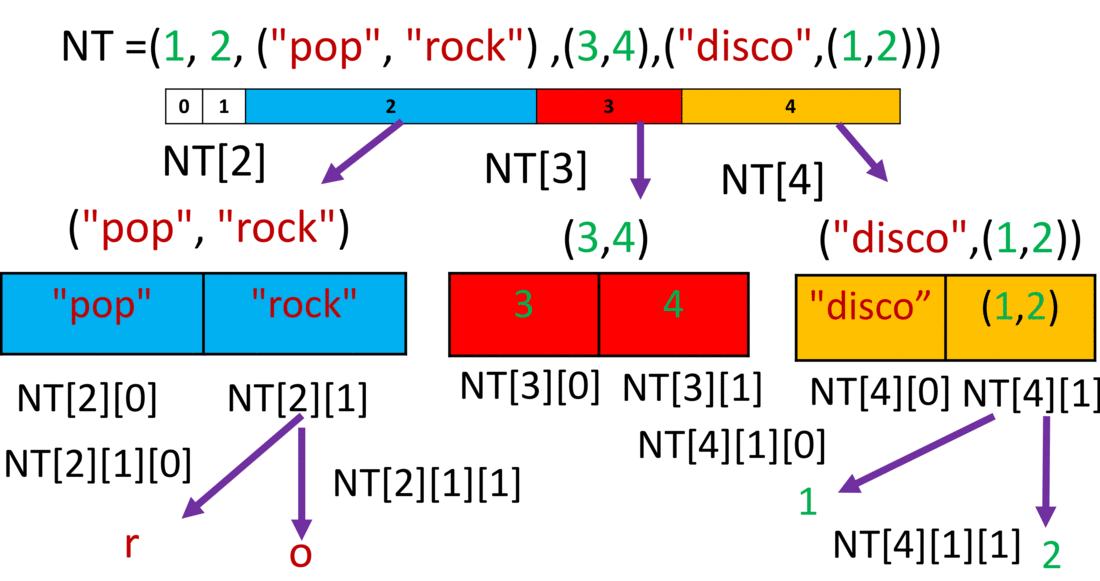Python Collections - Tuples in Python
The Python tutorials are written as Jupyter notebooks and run directly in Google Colab—a hosted notebook environment that requires no setup. Click the Run in Google Colab button.
Colab link - Open colab
Imagine you received album recommendations from your friends and compiled all of the recommandations into a table, with specific information about each album.
The table has one row for each movie and several columns:
- **artist** - Name of the artist
- **album** - Name of the album
- **released_year** - Year the album was released
- **length_min_sec** - Length of the album (hours,minutes,seconds)
- **genre** - Genre of the album
- **music_recording_sales_millions** - Music recording sales (millions in USD)
- **claimed_sales_millions** - Album's claimed sales (millions in USD)
- **date_released** - Date on which the album was released
- **soundtrack** - Indicates if the album is the movie soundtrack (Y) or (N)
- **rating_of_friends** - Indicates the rating from your friends from 1 to 10
The dataset can be seen below:
Artist Album Released Length Genre Music recording sales (millions) Claimed sales (millions) Released Soundtrack Rating (friends) Michael Jackson Thriller 1982 00:42:19 Pop, rock, R&B 46 65 30-Nov-82 10.0 AC/DC Back in Black 1980 00:42:11 Hard rock 26.1 50 25-Jul-80 8.5 Pink Floyd The Dark Side of the Moon 1973 00:42:49 Progressive rock 24.2 45 01-Mar-73 9.5 Whitney Houston The Bodyguard 1992 00:57:44 Soundtrack/R&B, soul, pop 26.1 50 25-Jul-80 Y 7.0 Meat Loaf Bat Out of Hell 1977 00:46:33 Hard rock, progressive rock 20.6 43 21-Oct-77 7.0 Eagles Their Greatest Hits (1971-1975) 1976 00:43:08 Rock, soft rock, folk rock 32.2 42 17-Feb-76 9.5 Bee Gees Saturday Night Fever 1977 1:15:54 Disco 20.6 40 15-Nov-77 Y 9.0 Fleetwood Mac Rumours 1977 00:40:01 Soft rock 27.9 40 04-Feb-77 9.5 In Python, there are different data types: string, integer and float. These data types can all be contained in a tuple as follows:

Now, let us create your first tuple with string, integer and float.
Tuples in Python
Welcome! This notebook will teach you about the tuples in the Python Programming Language. By the end of this lab, you'll know the basics tuple operations in Python, including indexing, slicing and sorting.
About the Dataset
Tuples
# Create your first tuple
tuple1 = ("disco",10,1.2 )
tuple1
The type of variable is a **tuple**.
# Print the type of the tuple you created
type(tuple1)
Indexing
Each element of a tuple can be accessed via an index. The following table represents the relationship between the index and the items in the tuple. Each element can be obtained by the name of the tuple followed by a square bracket with the index number:
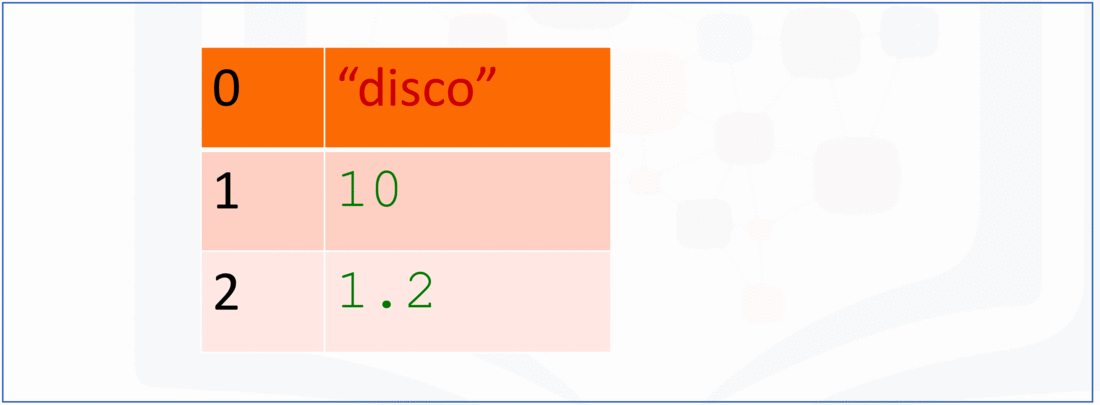
We can print out each value in the tuple:
# Print the variable on each index
print(tuple1[0])
print(tuple1[1])
print(tuple1[2])
We can print out the **type** of each value in the tuple:
# Print the type of value on each index
print(type(tuple1[0]))
print(type(tuple1[1]))
print(type(tuple1[2]))
We can also use negative indexing. We use the same table above with corresponding negative values:
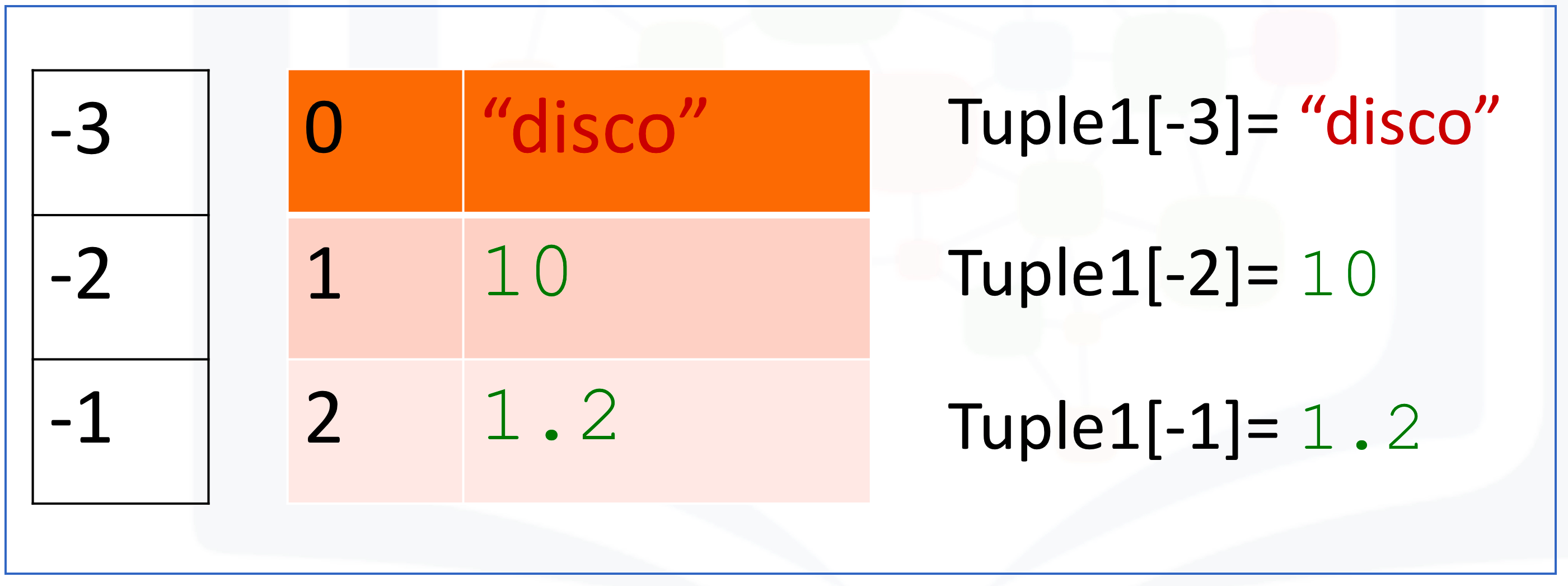
We can obtain the last element as follows (this time we will not use the print statement to display the values):
# Use negative index to get the value of the last element
tuple1[-1]
We can display the next two elements as follows:
# Use negative index to get the value of the second last element
tuple1[-2]
# Use negative index to get the value of the third last element
tuple1[-3]
Concatenate Tuples
We can concatenate or combine tuples by using the **+** sign:
# Concatenate two tuples
tuple2 = tuple1 + ("hard rock", 10)
tuple2
We can slice tuples obtaining multiple values as demonstrated by the figure below:
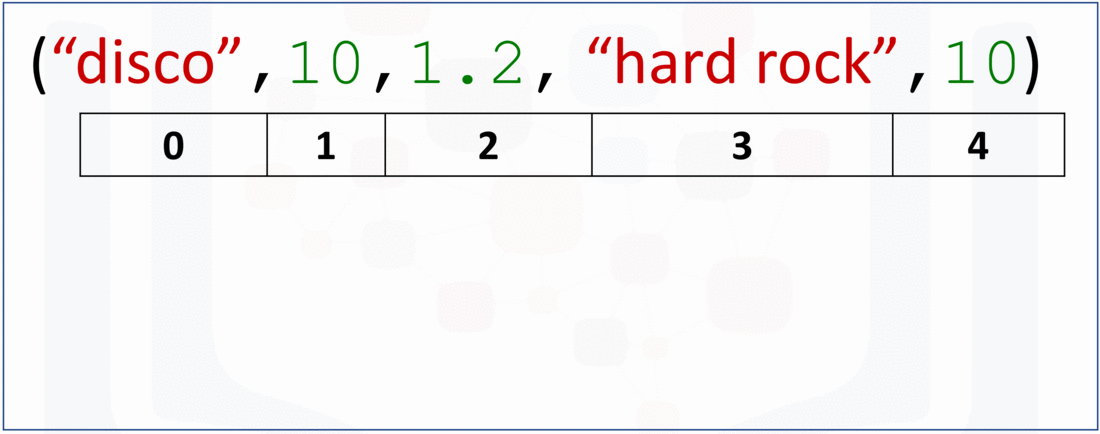
Slicing
We can slice tuples, obtaining new tuples with the corresponding elements:
# Slice from index 0 to index 2
tuple2[0:3]
We can obtain the last two elements of the tuple:
# Slice from index 3 to index 4
tuple2[3:5]
We can obtain the length of a tuple using the length command:
# Get the length of tuple
len(tuple2)
This figure shows the number of elements:
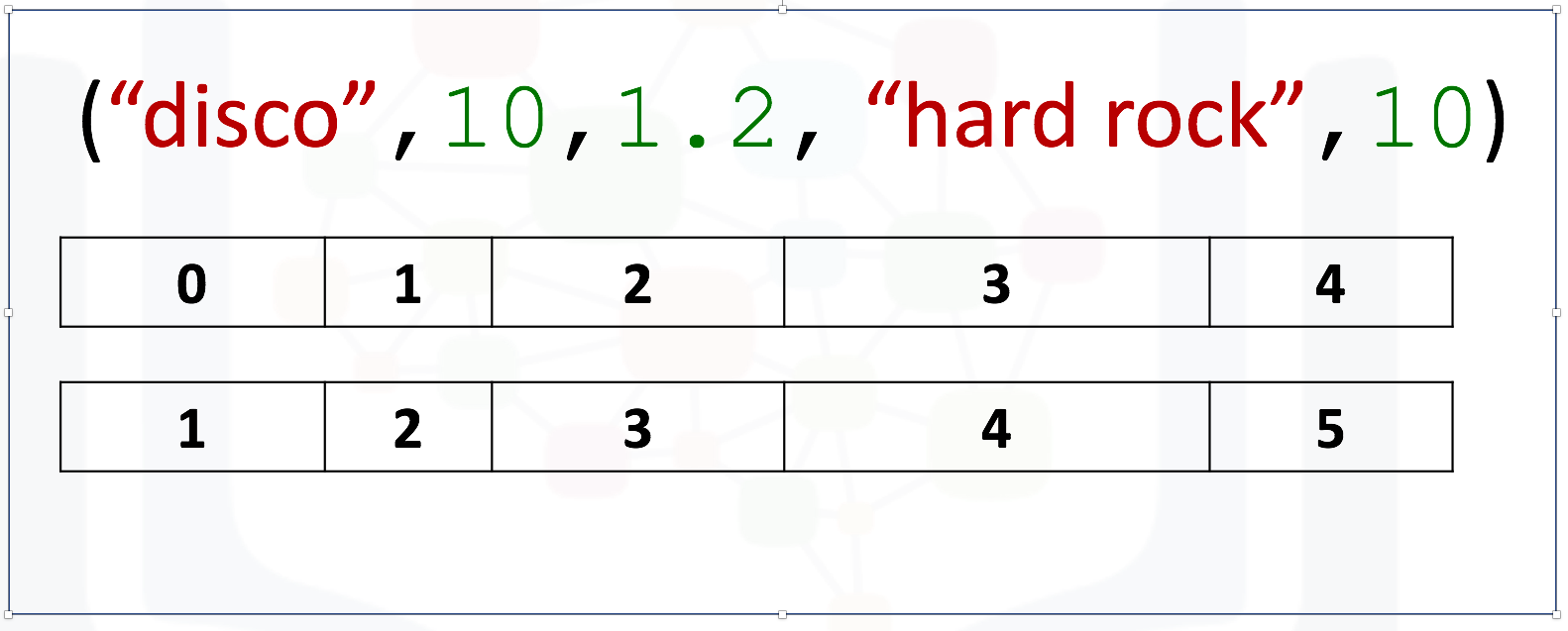
Sorting
Consider the following tuple:
# A sample tuple
Ratings = (0, 9, 6, 5, 10, 8, 9, 6, 2)
We can sort the values in a tuple and save it to a new tuple:
# Sort the tuple
RatingsSorted = sorted(Ratings)
RatingsSorted
Nested Tuple
A tuple can contain another tuple as well as other more complex data types. This process is called 'nesting'. Consider the following tuple with several elements:
# Create a nest tuple
NestedT =(1, 2, ("pop", "rock") ,(3,4),("disco",(1,2)))
Each element in the tuple including other tuples can be obtained via an index as shown in the figure:

# Print element on each index
print("Element 0 of Tuple: ", NestedT[0])
print("Element 1 of Tuple: ", NestedT[1])
print("Element 2 of Tuple: ", NestedT[2])
print("Element 3 of Tuple: ", NestedT[3])
print("Element 4 of Tuple: ", NestedT[4])
We can use the second index to access other tuples as demonstrated in the figure:

We can access the nested tuples :
# Print element on each index, including nest indexes
print("Element 2, 0 of Tuple: ", NestedT[2][0])
print("Element 2, 1 of Tuple: ", NestedT[2][1])
print("Element 3, 0 of Tuple: ", NestedT[3][0])
print("Element 3, 1 of Tuple: ", NestedT[3][1])
print("Element 4, 0 of Tuple: ", NestedT[4][0])
print("Element 4, 1 of Tuple: ", NestedT[4][1])
We can access strings in the second nested tuples using a third index:
# Print the first element in the second nested tuples
NestedT[2][1][0]
# Print the second element in the second nested tuples
NestedT[2][1][1]
We can use a tree to visualise the process. Each new index corresponds to a deeper level in the tree:

Similarly, we can access elements nested deeper in the tree with a fourth index:
# Print the first element in the second nested tuples
NestedT[4][1][0]
# Print the second element in the second nested tuples
NestedT[4][1][1]
The following figure shows the relationship of the tree and the element NestedT[4][1][1]:
